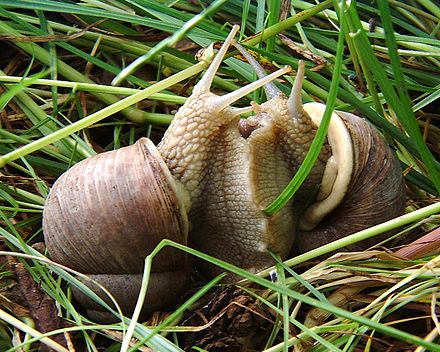Snails are a class of animals in the phylum Mollusca and class Gastropoda. They are widely distributed in various environments around the world. Gastropods are named for their soft, fleshy feet that secrete mucus and allow them to crawl along various surfaces. Snails include marine, freshwater and terrestrial species. Here are some detailed information and living habits about them.

Shell: Many snail species have a spiral shell, which is a hardened part of the snail's body that provides protection and support. Shell shape, size and color can vary widely depending on the species.
Body: The body of a snail consists of a head, a pair of sensory antennae (in species with eyes), a foot, and the visceral mass (located within the shell).
Foot: Their foot is a flat, muscular organ that allows for wave-like movements to help the snail move forward.
Activity: Most snails are nocturnal and prefer to move around in cool, moist environments. Since their skin needs to stay moist, intense sunlight and drought conditions can cause damage to them.
Diet: Snails feed primarily on plants, including leaves, flowers, stems, fruits, and decaying plant matter. Some species are carnivorous, or will eat other molluscs.
Reproduction: Many snails are hermaphroditic, meaning an individual has both male and female reproductive organs. Snails reproduce by laying eggs after mating.
Terrestrial snails: Like to live in a variety of terrestrial environments, such as gardens, forests, fields, and even desert areas. They usually search for food in moist areas.
Freshwater snails: Live in lakes, streams, ponds and rivers.
Marine Snails: Sea snails live in the ocean, from the intertidal zone to the deep ocean.
Conservation status: Many snail species are not threatened, but some are at risk of becoming endangered or already extinct due to factors such as habitat loss, climate change, pollution, and overharvesting.
Snails and Agriculture: Land snails are often considered pests in agriculture because they eat crops and garden plants.
French Cuisine: Certain snail species, especially the "drum snail" (Helix pomatia), are considered delicacies and play a prominent role in French cuisine.
Scientific research: Snails are also one of the model organisms for neuroscience research because of their relatively large and easily manipulated neurons.
Snails play multiple roles in ecosystems: they are decomposers, helping to break down and recycle nutrients; they are an important link in the food chain, providing a food source for other animals such as birds, insects and small mammals; and they play a role in balancing plant communities. also plays a role. Therefore, snails are an important part of biodiversity.
animal tags: snails
We created this article in conjunction with AI technology, then made sure it was fact-checked and edited by a Animals Top editor.